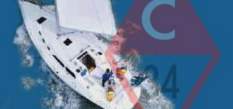I'll try to figure out how to load some photos or video. It really is quite remote and spectacular.
To answer Andy's question about the Raymarine wheel pilot steering, it did fine when asked. It wasn't asked to steer when I was having too much fun steering the boat down the swells in a following breeze. Nor was it asked to steer in some very confused seas/cross swells going around Estevan Point or Beale Point. It couldn't keep up, and it required a lot of concentration on my part to steer safely.
We never did meet the owners of the Catalina 350 which appeared in our anchorage sometime after dark. We left pretty early the next morning, and nobody was stirring as we motored out. They had Washington State registration numbers, but no home port indicated on their transom.
We did meet—of all people—another boat from Bainbridge Island in Barkley Sound. Not only that, they kept their boat (Halberg Rassy 42) in the same marina as us! But they were moving on to Bamfield and we were taking advantage of a weather window to sail all the way down the Strait of Juan de Fuca in one day. That was a 13 hour day, and those of you who have done it know there is really only one bail out point on the Canadian side (Port Renfrew) and the conditions were such that we pressed on to Sooke Harbor.
Although I haven't tallied up the exact distance covered, it was about 750 miles. A pretty serious trip, and one that challenged us in many ways.
Patches
To answer Andy's question about the Raymarine wheel pilot steering, it did fine when asked. It wasn't asked to steer when I was having too much fun steering the boat down the swells in a following breeze. Nor was it asked to steer in some very confused seas/cross swells going around Estevan Point or Beale Point. It couldn't keep up, and it required a lot of concentration on my part to steer safely.
We never did meet the owners of the Catalina 350 which appeared in our anchorage sometime after dark. We left pretty early the next morning, and nobody was stirring as we motored out. They had Washington State registration numbers, but no home port indicated on their transom.
We did meet—of all people—another boat from Bainbridge Island in Barkley Sound. Not only that, they kept their boat (Halberg Rassy 42) in the same marina as us! But they were moving on to Bamfield and we were taking advantage of a weather window to sail all the way down the Strait of Juan de Fuca in one day. That was a 13 hour day, and those of you who have done it know there is really only one bail out point on the Canadian side (Port Renfrew) and the conditions were such that we pressed on to Sooke Harbor.
Although I haven't tallied up the exact distance covered, it was about 750 miles. A pretty serious trip, and one that challenged us in many ways.
Patches
